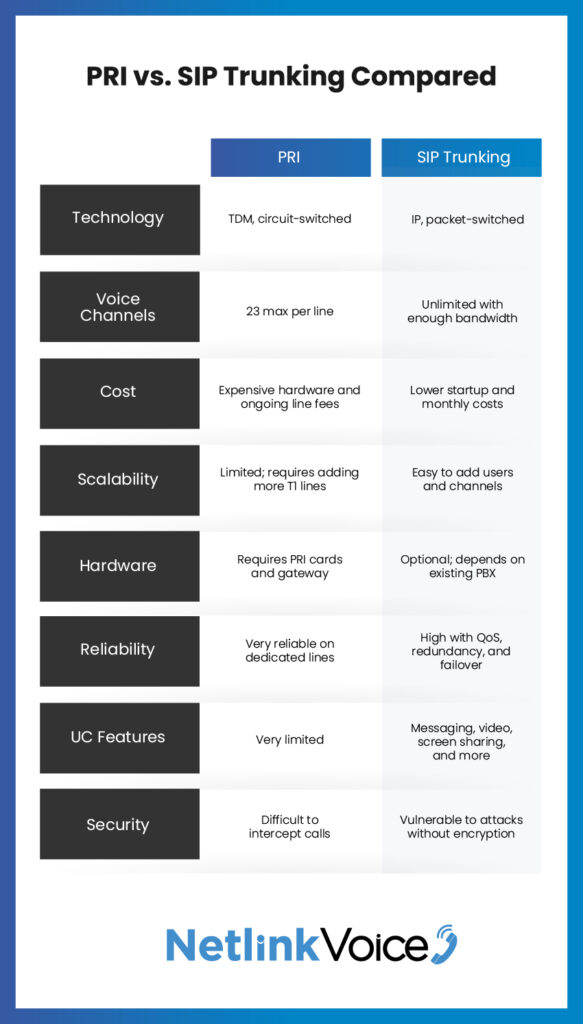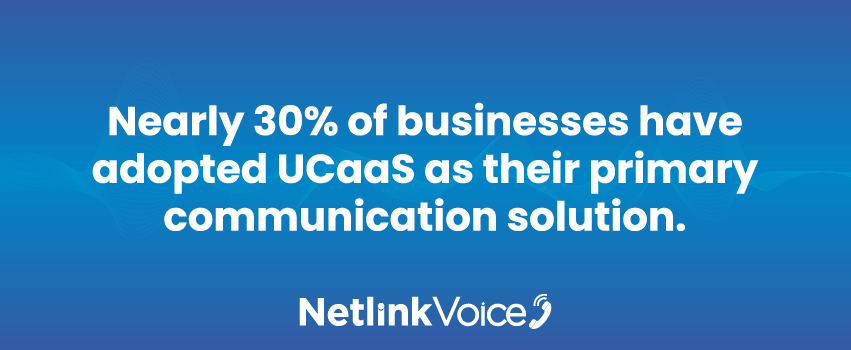TL;DR: PRI vs SIP Trunking
- PRI is a legacy, copper-based phone technology with dedicated lines and excellent reliability, but it’s expensive, limited to 23 concurrent calls per circuit, and difficult to scale.
- SIP trunking delivers calls over the internet, typically costs 30–40% less than PRI, and offers virtually unlimited call capacity as long as you have enough bandwidth.
- SIP easily supports remote and hybrid work, unified communications (voice, video, messaging), and business continuity, while PRI is mostly limited to voice on older on-prem PBXs.
- PRI may still work for businesses with stable, on-site operations and existing PRI hardware, but most growing, distributed organizations will benefit more from SIP trunking.
- With the right provider and security measures, SIP can match or exceed PRI reliability—and providers like Netlink Voice help you migrate from PRI to SIP smoothly with minimal downtime.
PRI vs SIP Protocol: A Brief Comparison
PRI vs SIP: PRI uses dedicated physical circuits that offer inherent security and stable call quality, but it depends on aging copper and scales in fixed channel blocks. SIP protocol runs over IP, delivering more features, mobility, easier scaling, and built-in disaster recovery. With robust connectivity and security, SIP can match or exceed PRI reliability.
As more businesses look to modernize their outdated phone systems, a pivotal decision awaits: should they stick with the tried-and-true Primary Rate Interface (PRI) technology or embrace Session Initiation Protocol (SIP) trunking?
SIP trunking is increasingly popular, with experts expecting the market to grow by 10% to over $15 billion in 2024.1 And with 62% of U.S. companies offering remote and hybrid working options,2 many organizations want to move away from inflexible PRI lines. On the other hand, legacy PRI systems might still be the best fit for your business’s specific communication needs.
In this blog, we’ll break down the core differences between these technologies to help you determine which is right for your organization.
What Is PRI?
Primary Rate Interface (PRI) is a legacy telephony technology that operates over traditional copper lines, providing digital connectivity from a business phone system to the public switched telephone network (PSTN).
The PSTN is the traditional national and regional telephone network that aggregates local telephone operators. When someone calls your business, the incoming call enters your private branch exchange (PBX), an on-premises private telephone network used within organizations to route calls between internal extensions and external numbers.
PRI’s direct digital connections have been the backbone of business phone systems for decades. Large companies rely on PRI for its consistency and to address the limitations of traditional analog phone lines. The PRI standard helps enterprises manage a high volume of calls across their sizable internal private networks.
PRI Requirements & Features
Using PRI for your business communications requires proper equipment and infrastructure. First, you need a PBX phone system compatible with PRI technology, which usually requires the installation of PRI card modules. A PRI gateway – which interfaces the PBX and modules with external PRI trunk lines – is also necessary to connect the PBX to the public telephone network.
To support the PRI trunk, copper wiring capable of transmitting on T1 lines must be installed or available at your office. Finally, you’ll need to purchase a service plan from a telecommunications provider to gain access to their PRI trunk network. Without procuring PRI access service, your PBX system won’t be able to complete external calls using PRI technology.
Some notable features of a PRI connection include:
Dedicated Phone Lines
A PRI trunk provides a consistent level of service and call quality with dedicated phone lines that rely on the PSTN for connectivity.
Fixed Channels
PRI lines consist of 23 bearer voice or data channels that transmit at 64 Kbps, meaning 23 calls can happen simultaneously.

The Pros & Cons Of PRI Trunking
PRI trunking delivers reliable and high-quality voice transmission, which has made it an enterprise telephony staple for years. However, PRI has some downsides, especially regarding flexibility and costs. Here are some pros and cons of using a PRI phone service:
Pros
-
- Proven reliability based on legacy telephone technology
-
- Dedicated, point-to-point connections unaffected by other network traffic
-
- Consistent call quality with minimal latency
-
- Works with older PBX systems and analog phones
-
- More challenging to intercept calls versus IP-based systems
Cons
-
- Expensive upfront costs for proprietary PRI hardware
-
- Ongoing PRI line charges and per-minute long-distance fees
-
- Limited to only 23 concurrent calls per PRI circuit
-
- Difficult to scale and add new phone lines or numbers
-
- Doesn’t support unified communications capabilities
-
- Doesn’t work natively with VoIP phones
What Is SIP Trunking?
Session Initiation Protocol (SIP) trunking is a modern alternative to legacy PRI systems that delivers voice calls over an Internet Protocol (IP) network. With SIP trunking, analog call signals are digitized and transmitted as data packets rather than relying on dedicated lines.
SIP trunking uses the SIP internet protocol to link your business’s IP-based PBX system to the public switched telephone network (PSTN) via an internet connection. Unlike PRI, a SIP trunk consolidates multiple communications channels into a virtual trunk rather than having distinct physical lines for each voice or data transmission path. This provides more efficient use of connectivity resources and the flexibility to add or replace lines as needed.
With SIP trunking solutions, the service provider typically hosts and handles the backend equipment, eliminating the need for companies to maintain proprietary on-premises hardware themselves. By digitizing voice communications and leveraging IP networking to transmit phone calls, SIP trunks allow businesses to move beyond the physical limitations of legacy telephony systems.
SIP Features & Requirements
To implement SIP trunking, your business needs an IP PBX phone system that supports SIP technology and protocols. High-speed connectivity is also required to handle voice and UC traffic, as the quality and reliability of the SIP trunk service depends on having sufficient symmetrical internet bandwidth available.
SIP phones or VoIP adapters are needed for your end users to connect to the IP PBX. Finally, you’ll have to partner with a reputable SIP service provider, who will:
-
- Manage your cloud-based sessions and PSTN connectivity
-
- Port your business phone numbers
-
- Monitor and maintain the network’s physical infrastructure
-
- Provision voice calls and network capacity
-
- Support business continuity requirements
SIP trunking connections offer businesses many features, including:
Direct Inward Dialing
A SIP trunk supports direct inward dialing (DID), which enables businesses to assign direct phone numbers without needing physical lines for each one.
IP-Based Integrations
Unlike PRI, which only enables voice communications, SIP trunks can integrate voice with other IP-based services, such as video calls and messaging services, over a single data connection.

Workforce Mobility
The virtual connections SIP trunks provide allow remote and mobile workers to use desktop and mobile applications from any device or location.
Reliable IP Networks
A good SIP trunking provider maintains resilient IP network architecture across multiple geographically dispersed data centers to deliver high uptime and call quality.
The Pros & Cons Of SIP Trunking
For many modern businesses, SIP trunking provides significant cost, scalability, and flexibility advantages compared to legacy PRI systems. However, SIP technology also comes with its own limitations to factor in. Here are some pros and cons of using SIP trunks:
Pros
-
- Significant cost savings over PRI lines
-
- Easy scalability as your business grows
-
- High call quality with QoS prioritization
-
- Enhanced mobility and business continuity
-
- Unified communications and collaboration integrations
-
- Usage-based pricing model
Cons
-
- Dependency on the quality of internet connectivity
-
- Potential voice quality issues if bandwidth is insufficient
-
- Increased susceptibility to cybersecurity threats
-
- Need to replace older analog PBX systems and phones
PRI vs SIP Trunking Compared
When selecting a business communications system, it’s crucial to understand the core differences between PRI and SIP trunking technology. If you’re deciding between SIP vs. PRI, this section can help determine which solution best fits your company’s current and future needs.

Technology
Primary Rate Interface uses time-division multiplexing technology, which allows multiple voice channels to be carried over a single copper wire line. A SIP trunk, on the other hand, leverages an IP network to establish virtual sessions for voice data transmissions. This fundamental difference in the underlying technologies impacts scalability, hardware requirements, and available features between the two systems.
Voice Channels
Both PRI and SIP enable simultaneous calls. However, a traditional PRI line allows for only 23 concurrent voice calls at once. A SIP trunk has virtually unlimited concurrent channels, constrained only by the available bandwidth. This makes SIP trunking much more scalable for growing communications needs.
Cost
PRI service from telecom providers involves high initial setup costs for the lines and hardware gateways, and ongoing flat monthly fees per channel. With SIP lines typically 30-40% cheaper than PRI,3 choosing the right SIP provider can help businesses save on calling costs by leveraging existing internet connections and offering usage-based billing.
Scalability
Adding more voice capacity with a PRI phone service requires physically installing additional dedicated copper line circuits, which is cumbersome and costly. SIP trunking makes it easier for companies to scale their virtual connections up or down through software configuration changes without having to add new physical lines.
Hardware
PRI requires specialized hardware and gateways installed on-premises to connect business phone systems to telephone company lines. A SIP trunk can work with a standard internet connection and existing PBX systems, minimizing the need to install proprietary hardware or adjust on-site physical infrastructure.
Reliability
PRI lines offer consistent uptime and reliability, given that they provide a dedicated end-to-end physical connection. SIP trunking can match and exceed this level of reliability by employing techniques like quality of service prioritization, network redundancy, and automatic failover between internet connections.
Unified Communications
PRI phone systems support only basic voice communication. SIP enables UCaaS platforms, which nearly 30% of businesses have adopted as their primary communication solution as of 2023.4 A SIP trunk can easily integrate voice and data transmissions, including messaging, video conferencing, screen sharing, and the other UC features modern businesses demand.
Security
Because the physical PRI circuit is closed, it’s very difficult for phone calls to be intercepted or eavesdropped upon. SIP trunking operates over an open Internet connection, so it has inherent vulnerabilities that must be addressed through encryption and other security measures.

Migrating From PRI To SIP: A Seamless Transition
As businesses increasingly seek more cost-effective and scalable communication solutions, many are choosing to migrate from legacy PRI systems to modern SIP trunking. With Netlink Voice, this transition becomes smoother and more efficient, offering reliable support and tailored solutions to ensure your communication infrastructure is future-ready.
Evaluate Your Current Infrastructure
The first step in the migration process is assessing your existing PRI infrastructure. Ensure your network is capable of handling SIP trunking, which requires sufficient bandwidth and a reliable internet connection. Upgrading to a dedicated high-speed connection may be necessary to support the increased traffic SIP systems demand.
Choose The Right SIP Provider
Transitioning to SIP requires selecting a provider that can meet your business’s needs. With Netlink Voice’s SIP trunking services, you gain access to high-quality voice solutions, excellent customer support, and the flexibility to scale your services as your business grows. Netlink Voice offers customized hybrid solutions, allowing you to maintain some PRI lines during the migration for a phased and stress-free transition.
Minimize Downtime With Expert Planning
One of the main concerns when switching from PRI to SIP is minimizing downtime. Netlink Voice works with you to plan the migration process during non-peak hours, ensuring minimal disruption to your business operations. Our phased migration approach allows PRI and SIP systems to run in parallel until you’re fully confident in the new setup.
Test & Optimize With Confidence
Before fully committing to SIP, conduct thorough testing of your new system. Test call quality, security features, and redundancy plans to ensure everything functions as expected. Proper testing will help identify any potential issues early on, allowing for adjustments before final deployment.
Train Your Team For Success
Finally, ensure your team is well-prepared for the switch. While SIP systems tend to be user-friendly, providing training for your employees on how to use the new system will guarantee a smoother transition and minimize potential disruptions.
By carefully planning your migration from PRI to SIP, you can unlock the numerous advantages of SIP trunking—including cost savings, scalability, and advanced features—without sacrificing the reliability your business needs to thrive. Netlink Voice’s expertise and dedicated support ensure that your transition is not only seamless but also future-proofs your communications infrastructure.
PRI vs SIP Trunking FAQs
Which Is More Reliable For US Businesses, PRI Or SIP?
Both can be highly reliable. PRI is stable but bound to a single physical circuit. SIP can meet or exceed PRI reliability with dual ISPs, QoS/SD-WAN, SBCs, geo-redundant trunks, and provider SLAs.
Is PRI More Secure Than SIP?
PRI’s physical isolation provides inherent security. SIP can be equally secure using TLS/SRTP encryption, SBCs, strict firewalling, and monitoring, often exceeding PRI when best practices are applied.
How Do Scalability And Costs Compare?
PRI scales in 23-channel blocks and typically requires hardware and installation. SIP scales per channel, supports burst capacity, and usually lowers total cost while adding features and flexibility.
What Do I Need To Make SIP As Reliable As PRI?
Business-grade internet (preferably dual carriers), QoS or SD-WAN, an SBC, power backup, and geo-redundant failover from the provider. Validate E911 details and run failover tests.
When Does PRI Still Make Sense?
In sites without dependable broadband, legacy PBXs lacking SIP support, or specific regulated environments that require dedicated circuits, though copper retirements limit long-term viability.
Can I Keep My Phone Numbers When Moving From PRI To SIP?
Yes. Use number porting with a clear cutover plan, update E911 service addresses, and test call routing and failover before decommissioning PRI.
PRI vs SIP Trunks: Get The Right Phone System For Your Business With Netlink Voice
When selecting a business phone system, understanding your communication needs and expected growth is essential to choosing a solution that aligns with your goals. While both PRI and SIP technology are reliable options, SIP trunking typically provides greater flexibility, scalability, and mobility for businesses to support a distributed workforce. With the right internet connectivity and cybersecurity measures, a SIP trunk can rival – or exceed – the reliability of legacy PRI systems.
Netlink Voice makes it easy for organizations to unlock the advantages of SIP trunking with tailored solutions that work seamlessly with your PBX. With our cloud-based ConnectWare phone system, you get nationwide long-distance calling, flat-rate monthly bills, and the flexibility to scale your voice services as needed. Ready for hassle-free business communications? Connect with Netlink Voice today to learn more about our SIP trunking services.
Sources:
-
- https://www.thebusinessresearchcompany.com/report/session-initiation-protocol-trunking-services-global-market-report
- https://www.forbes.com/sites/karadennison/2024/01/24/how-the-flexible–remote-work-debate-will-carry-into-2024
- https://www.geeksforgeeks.org/difference-between-sip-and-pri
- https://www.techtarget.com/searchunifiedcommunications/tip/How-to-evaluate-top-UCaaS-providers-and-vendors-of-2023

